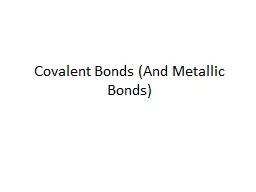

COVALENT BOND bond formed by the sharing of electrons Covalent Bonds Between nonmetallic elements of similar electronegativity Electronegativity how badly an atom wants to add an electron non metals have higher electronegativity ID: 341426
Download Presentation The PPT/PDF document "Covalent Bonds (And Metallic Bonds)" is the property of its rightful owner. Permission is granted to download and print the materials on this web site for personal, non-commercial use only, and to display it on your personal computer provided you do not modify the materials and that you retain all copyright notices contained in the materials. By downloading content from our website, you accept the terms of this agreement.
Slide1
Covalent Bonds (And Metallic Bonds) Slide2
COVALENT BOND
bond
formed by the
sharing
of
electrons Slide3
Covalent
Bonds
Between nonmetallic elements of similar electronegativity
.
Electronegativity = how badly an atom wants to add an electron (non metals have higher electronegativity)
Formed by sharing electron pairs
Stable non-ionizing particles, they are not conductors at any state
Examples; O
2
, CO
2
, C
2
H
6
, H
2
O,
SiCSlide4
Covalent BondsSlide5
Bonds in all the polyatomic ions and diatomics are all covalent bondsSlide6
when electrons are shared
equally
NONPOLAR
COVALENT BONDS
H
2
or Cl
2Slide7
2. Covalent bonds-
Two atoms share one or more pairs of outer-shell electrons.
Oxygen Atom
Oxygen Atom
Oxygen Molecule (O
2
)
Slide8
when electrons are shared but shared
unequally
POLAR COVALENT BONDS
H
2
OSlide9
Polar Covalent Bonds: Unevenly matched, but willing to share.Slide10
- water is a
polar
molecule
because oxygen is more electronegative than hydrogen, and therefore electrons are pulled closer to oxygen.Slide11
How to determine which type of covalent bond it is, using electronegativity:
Subtract the two values for electronegativity for the two elements.
Take the absolute value
Match to category.
*Remember – higher electronegativity values - more electronegative! Slide12Slide13Slide14
METALLIC BOND
bond found in
metals; holds metal
atoms together
very stronglySlide15
Metallic Bond
Formed between atoms of metallic elements
Electron cloud around atoms
Good conductors at all states, lustrous, very high melting points
Examples; Na, Fe, Al, Au, CoSlide16
Metallic Bonds: Mellow dogs with plenty of bones to go around.Slide17
Ionic Bond, A Sea of ElectronsSlide18
Metals Form Alloys
Metals do not combine with metals. They form
Alloys which is a solution of a metal in a metal.
Examples are steel, brass, bronze and pewter.Slide19
Formula Weights
Formula weight is the sum of the atomic masses.
Example- CO
2
Mass, C + O + O
12.011 + 15.994 + 15.994
43.999
Slide20
Practice
Compute the mass of the following compounds round to nearest tenth & state type of bond:
NaCl;
23 + 35 = 58; Ionic Bond
C
2
H
6
; 24 + 6 = 30; Covalent BondNa(CO3)2;
23 + 2(12 + 3x16) = 123; Ionic & CovalentSlide21